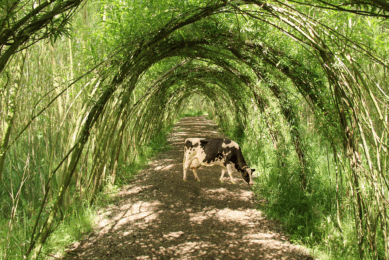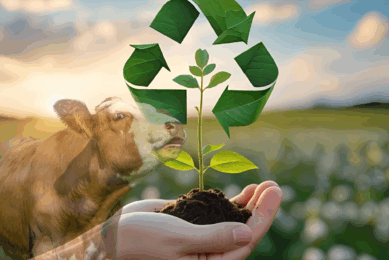IKEA’s dedication to sustainability

The food business of IKEA is growing at a rapid pace and is offering packaged food or meals to over 680 million guests per year. Sustainable farming and conscious sourcing of feed ingredients are therefore on top of mind.
Large food companies, including retailers and those active in the foodservice are increasingly looking for ways to make the agri-food system more sustainable. And these large corporate firms are not only looking at the way animals are raised. They also have an increased interest in what the animals eat and where the feed ingredients are sourced. One of the big players that is actively looking to make the food they sell more sustainable is IKEA. IKEA recently announced its active participation in the FEED-X programme, part of Project X, a WWF founded corporate accelerator which helps organisations adopt sustainable innovations in their supply chains. We asked Christoph Mathiesen, Sustainability Developer at IKEA Food, to explain more about the plans to delve deeper into animal (aqua)feed. His job is fully dedicated to sustainability in the IKEA food business. Mr Mathiesen works directly with suppliers and advisors on how the IKEA Food business can achieve the sustainability goals that it has set.
 Christoph Mathiesen, Sustainability Developer at IKEA Food, works directly with suppliers and advisors on how the IKEA Food business can achieve the sustainability goals that it has set. Photo: IKEA Christoph Mathiesen, Sustainability Developer at IKEA Food, works directly with suppliers and advisors on how the IKEA Food business can achieve the sustainability goals that it has set. Photo: IKEA |
All About Feed (AAF): IKEA is known for its furniture, but the food section in the IKEA stores is growing as well. Can you explain what IKEA’s vision is on being a food seller?
Christoph Mathiesen (CM): ”With food at the heart of people’s everyday life, in the IKEA Food business we want to offer a modern taste of Sweden – honest food for people and the planet. In line with people’s great interest in food, the IKEA food business contributes to the growth of IKEA by attracting visitors in itself and by being a key part of the IKEA shopping experience. In the purchasing organisation of the IKEA Food business where I work, we are working closely together with IKEA Food Services AB, which is developing the global range for IKEA Restaurants, Bistros, Swedish food markets and other touch points in over 52 markets. IKEA opened its first restaurant in 1959 and has now grown into a global food business. Today, over 680 million guests per year enjoy food at IKEA. In the fiscal year 2018, the total turnover of the IKEA food business was € 2.15 billion, which contributes around 5% to the total IKEA turnover.”
AAF: What is the current sustainability policy of IKEA when it comes to food?
CM: “IKEA has a sustainability strategy called People and Planet Positive, where three focus areas are defined: Firstly: Healthy and sustainable living (offering healthy and sustainable food that is delicious and affordable). The second focus is circular and climate positive (helping create a circular food system that positively impacts the people, animals and the environment). And last but not least, fair and equal (respecting human rights and promoting diversity and empowerment of workers). To go more into depth in how we in the IKEA food business can apply above focus areas into our business, we have a specific IKEA Food Health and Sustainability plan to inspire and guide us.”
AAF: What are the most difficult items to make more sustainable?
CM: “The sustainability challenges vary between the raw materials we use in our products. This depends on the nature of the material or ingredient, where and how it is produced and the supply chains. We want to be a responsible business and sourcing critical commodities such as coffee, tea and cocoa or certain raw materials such as fish and seafood in a responsible way is a natural contribution to these ambitions. For these ingredients we work with third party certifications schemes, because we believe they support positive developments in the food industry and bring more transparency in supply chains. With some raw materials we have been involved longer in securing environmental sustainability and so the challenges are better understood and in some cases mitigated. With other materials, we are in an earlier stage of the sustainability improvement journey and here we are faced with more uncertainties and a need for mapping the risks. In the end, it all comes down to that we want to offer customers food products that are sourced in a responsible way – this goes for both animal-based products and plant-based products.”

Sustainable Livestock Farming: Achieving sustainability goals in livestock farming, needs to be a collaborative effort between policymakers, farmers and consumers. Measures taken now, act as an insurance policy for future generations, to ensure a safe and abundant food for the growing global population. A selection of articles on the topic…
AAF: IKEA sells a lot of fish products as well. What is the vision for this regarding sustainability?
CM: “IKEA has committed to source seafood from sustainable fisheries and responsible farms being MSC or ASC certified. Next to this commitment we also look into animal feed. We know that the feed used in salmon farming constitutes a large part of the environmental footprint in salmon production. Thus we have chosen to look for solutions to how we can make the feed more sustainable and less dependent on material input from wild caught fish and feed crops like soy and palm oil that may be associated with deforestation and natural habitat loss.”

AAF: Your company is also part of the newly launched FEED-X challenge, aimed to transform the global feed industry with a focus on aquafeed. Why did you get involved in this?
CM: “By 2030, IKEA wants to inspire and enable more than 1 billion people to live a better everyday life within the limits of the planet. To contribute to reaching this ambition, we also want to reduce the environmental footprint from our food business. Working together with our suppliers, we aim to identify solutions that have a positive impact and thus we have also chosen to work with animal feed. We want to contribute to reducing the impact that animal feed production is having on the environment, biodiversity and climate changes. I see the collaboration with FEED-X as a great opportunity to support sustainable food systems and accelerate the innovation in animal feed. Because of the science based approach in the FEED-X challenge and the close collaboration with feed producers and innovators, I believe this is a credible and solid way to identify the best available solutions and get these implemented into the global aquaculture industry. Togetherness is a strong IKEA value – we believe positive change can be made by working together. We are in dialogue with relevant experts and organisations and we also ask for advice from industry players who are working with innovative approaches and with solutions that have been tried out.”

AAF: What is your definition of sustainable fish feed? And how will IKEA work towards sustainable (salmon) feed in the coming years?
CM: “For us the two basic criteria for sustainable feed are that the production of the feed is not contributing to deforestation and/or overfishing. My colleagues and I are currently in dialogue with feed suppliers and innovators on how we can promote better feed solutions that lead to improved digestibility, lower GHG’s emissions and better animal health. Our participation in the FEED-X challenge is part of this. In addition, the IKEA Food business is currently developing the IKEA Food Better Programmes to address and focus our ambitions around animal welfare and more sustainable agriculture. These programmes are species-specific for all major species in our supply-chain – chickens, laying hens, pigs, salmon, beef and dairy cattle. Part of developing these programmes is to ensure that animal feed does not contribute to deforestation.”
AAF: Do you see things changing at other large companies as well when it comes to sustainability in the food chain?
CM: “I believe that more companies, such as retailers but also farmers and processors, are looking into the full supply chain. Sustainability is increasingly being seen as part of the business solution that will also help secure the resources we depend on and help identify the most professional and committed suppliers. I also believe that a growing demand for more sustainable solutions will challenge the food and feed business. We see that traceability for feed ingredients such as soy and palm oil is gradually becoming a basic industry requirement. Feed companies and farmers that will be able to provide the documentation that retailers and consumers are requesting will then have an advantage on the market. The demand for innovative and documented solutions is stressing the importance of feed companies and solution providers to work closely together and promote transparency and sharing of knowledge.”











